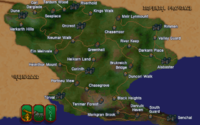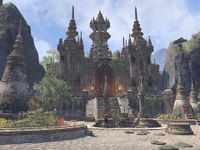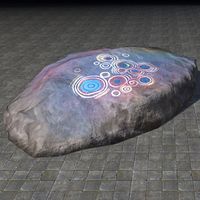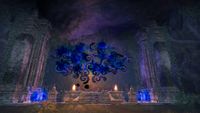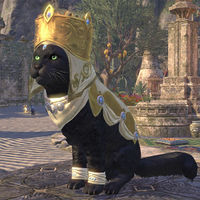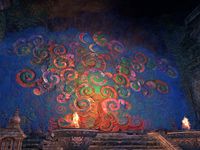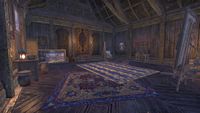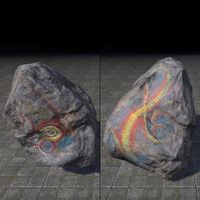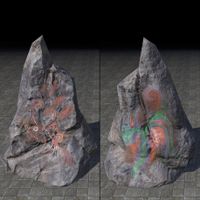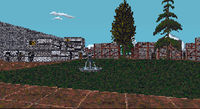Lore:Black Heights
| Black Heights | |
|---|---|
| Type | Settlement |
| Continent | Tamriel |
| Province | Elsweyr |
| Region | Pellitine (Tenmar Forest) |
| Appears in | Arena, ESO |
Black Heights is a small village in the outlying hills of the Tenmar Forest and is located in the province of Elsweyr. Most of the people in town have a deep devotion to the arts and produce some of the highest quality paints and dyes in Tamriel.[1] Its people have a great reverence for Khenarthi, the Khajiiti goddess of winds and worship her from Khenarthi's Breath Temple, an ornate temple in the town's southern outskirts and marginally run by an Alfiq priesthood.[2]
Contents
Layout and Geography[edit]
Black Heights is nestled in a mountain valley at the edge of the Tenmar Forest and dotted with large, painted stones.[1] Much of the town is built around a waterfall from the central mountains and the river basin that flows down the Quin'rawl peninsula and into the seas.[3] A path travels west past Black Heights and leads toward a cave containing the Wall of Life, an ancient mural at the base of the mountain.[4]
Some of the pigments created by the locals come from the wilderness outside of town. The bark of White sycamores, for example, are used to create some of the purest white colors. These trees are also holy symbols of Khenarthi as the wind carries their seed across the land. While others suggest that water beetles can provide quality blue pigments, the blue poppy can be used to create the color.[5] The Terror birds that live outside of Black Height keep Senche from town.[4] Black Heights is neighbored by several settlements, including Duncori Walk to the far north-northeast, Markgran Brook to the south, and Tenmar Forest to the west.[6]
Notable Locales[edit]
|
|
History[edit]
In the late First Era, concurrent to the reign of Reman I,[8] a great battle ensued at Doomstone Keep in which the dragon, remembered in Khajiiti legend as the "Demon from the East", was defeated by the warrior, Ja'darri and sealed in the ruins by the ancient Dragonguard. Despite that, Ja'darri died from her injuries[9] and her body was taken to Khenarthi's Breath Temple, where moon-priests tended to her for four days and nights. On the final night, when the moons were full, Khenarthi appeared before them and brought her to the Spilled Sand, the mythical realm of Alkosh far beyond the Sands Behind the Stars. The legend of her passing would go on to live in oral tradition.[10]
Sometime in the Second Era, a grieving Khajiiti father named Dak'radhi was manipulated by Namiira to paint an accursed mural and become her servant. In doing so, the Wall of Life was cracked and spewed dark magic. At a much later time, Dak'radhi attempted to draw his son, Vijari to the Darkness with him and started his transition into a dro-m'athra. Ka'ishka, his wife sought help from her sister, a Twilight Cantor named Adara'hai who together with a traveler investigated all throughout town. Once they realized his father was the cause of his strife, they replicated the same process Dak'radhi partook in and painted a mural with peace and love in mind. As Vijari works to mend the Wall of Life, both Adara'hai and the traveler traversed the corrupted Passage of Dad'na Ghaten and exorcised Dak'radhi's spirit. With the wall restored, Vijari was able to pass in peace.[11]
At around the same time, the Dragonguard approached Clan Mother Tadali and hoped she would use her skills to locate a dragon named Yahgrondu. However, in order to call upon Khenarthi's aid, they needed to retrieve one of the lost sacred bells stolen by her son, Za'ji. Both Za'ji and his companion traveled to Moonlit Cove, where they recovered the bell.[12]
During the Imperial Simulacrum in the late Third Era, the village of Black Heights was an active settlement. It was ruled by Lady Fajjan and had a rivalry with several other villages, namely Chasegrove, Duncori Walk, and Markgran Brook.[7]
Known Rulers[edit]
By the mid-Second Era, Black Heights' leading authority was known as the clan leader and lived in Khenarthi's Breath Temple as a priest as well.[13]
- Unknown Period
- Clan Mother Vaban-ko[14]
- The Second Era
- The Third Era
Culture and Society[edit]
—Blessed Clan Mother Vaban-ko
As a town of artistic intrigue, Black Heights' main form of export is the art its people have created or the pigments and dyes that its artisans made from the local colorwork. Many people from across Tamriel buy these colors and that alone has supported Black Heights. Their technique has been refined over generations and their work has been inspired by tradition carried over since the town's founding.[1]
Although camels are not typically found in the region, the Khajiit of Black Heights like to decorate them in pigments and sleeking oil.[15] Senche-Servals are also given such a treatment. High-quality pigments on their fur can withstand certain weather conditions and the artists claim they preen while they are painted.[16]
The people of Black Heights worship Khenarthi as the local place of worship, Khenarthi's Breath Temple is dedicated to her.[2] At the end of their life, citizens contribute to the Wall of Life by painting their final work for their loved ones, a leaf to the ever-growing tree on the ancient mural.[1] It is an act in which they relieve their souls of any burden before,[4] they enter the Passage of Dad'na Ghaten, a path that starts behind the mural and ascends up a mountain. Ringing the Khenarthic bells strewn across the path signals the goddess their arrival, and that they are ready to be flown to the Sands Behind the Stars.[17]
Gallery[edit]
See Also[edit]
- For game-specific information, see the Arena and Elder Scrolls Online
 articles.
articles.
Books[edit]
- The Colorful Khajiit by Eutropia Laetonius — An author's description of a Dagi village
References[edit]
- ^ a b c d The Colorful Khajiit — Eutropia Laetonius
- ^ a b Khenarthi's Breath Temple in ESO: Dragonhold
- ^ Southern Elsweyr in ESO: Dragonhold
- ^ a b c Ka'ishka's dialogue in ESO: Dragonhold
- ^ Vijari's dialogue in ESO: Dragonhold
- ^ Map of Elsweyr – The Elder Scrolls Arena
- ^ a b c d Black Heights location and rumors in Arena
- ^ Grandmaster Vashu-Pir
- ^ Sai Sahan's dialogue in ESO: Dragonhold
- ^ Za'ji's dialogue in ESO: Dragonhold
- ^ Chiaroscuro Crossroads quest in ESO: Dragonhold
- ^ Uneasy Alliances story quest in ESO: Dragonhold
- ^ a b Clan Mother Tadali's dialogue in ESO: Dragonhold
- ^ Passage of Dad'na Ghaten loading screen text in ESO: Dragonhold
- ^ Black Heights Camel mount description in ESO
- ^ Oleander Senche-Serval mount description in ESO
- ^ Adara'hai's dialogue in ESO: Dragonhold

